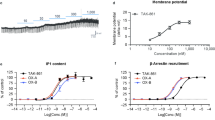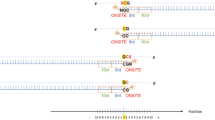Abstract
Narcolepsy presents one of the tightest associations with a specific HLA antigen (DQB1*0602) but there is strong evidence that non-HLA genes also confer susceptibility. Recent observations have implicated the hypocretin/orexin system in narcolepsy in both humans and animals. In addition, the implication of monoaminergic systems in the pathophysiology of narcolepsy is well established and a significant association between the monoamine oxydase-A (MAO-A) gene and human narcolepsy has recently provided a possible genetic link. We investigated polymorphisms of MAO-A and catechol-O-methyltransferase (COMT) in 97 Caucasians with well-defined narcolepsy-cataplexy and sought for genotypic effects on disease symptoms. No evidence of association between genotype or allele frequencies of both MAO-A or COMT gene and narcolepsy was found. However, a sexual dimorphism and a strong effect of COMT genotype on disease severity were found. Women narcoleptics with high COMT activity fell asleep twice as fast as those with low COMT activity during the multiple sleep latency test (MSLT) while the opposite was true for men. COMT genotype also strongly affected the presence of sleep paralysis and the number of REM sleep onsets during the MSLT. In agreement with well-documented pharmacological results in canine narcolepsy, this study reports the first genetic evidence for the critical involvement of the dopaminergic and/or noradrenergic systems in human narcolepsy.
This is a preview of subscription content, access via your institution
Access options
Subscribe to this journal
Receive 12 print issues and online access
$259.00 per year
only $21.58 per issue
Buy this article
- Purchase on SpringerLink
- Instant access to full article PDF
Prices may be subject to local taxes which are calculated during checkout

Similar content being viewed by others
References
Aldrich MS . Narcolepsy Neurology 1992 42 (suppl 6): 34–43
Gelineau JBE . De la narcolepsie Gazette des Hôpitaux (Paris) 1880 53: 626–628
Lin L, Faraco J, Li R, Kadotani H, Rogers W, Lin W et al. The sleep disorder canine narcolepsy is caused by a mutation in the hypocretin (orexin) receptor 2 gene Cell 1999 98: 365–376
Chemelli RM, Willie JT, Sinton CM, Elmquist JK, Scammell T, Lee C et al. Narcolepsy in orexin knockout mice: molecular genetics of sleep regulation Cell 1999 98: 437–451
Mignot E, Tafti M, Dement WC, Grumet FC . Narcolepsy and immunity Adv Neuroimmunol 1995 5: 23–37
Rogers AE, Meehan J, Guilleminault C, Grumet FC, Mignot E . HLA DR15 (DR2) and DQB1*0602 typing studies in 188 narcoleptic patients with cataplexy Neurology 1997 48: 1550–1556
Guilleminault C, Grumet C . HLA DR2 and narcolepsy: not all narcoleptic-cataplectic patients are DR2 Hum Immunol 1986 17: 1–2
Mignot E . Genetic and familial aspects of narcolepsy Neurology 1998 50 (suppl 1): S16–S22
Nishino S, Ripley B, Overeem S, Lammers GJ, Mignot E . Hypocretin (orexin) deficiency in human narcolepsy Lancet 2000 355: 39–40
Peyron C, Faraco J, Rogers W, Ripley B, Overeem S, Charnay Y et al. A mutation in a case of early onset narcolepsy and a generalized absence of hypocretin peptides in human narcoleptic brains Nat Med 2000 6: 991–997
Thannickal TC, Moore RY, Nienhuis R, Ramanathan L, Gulyani S, Aldrich M et al. Reduced number of hypocretin neurons in human narcolepsy Neuron 2000 27: 469–474
Koch H, Craig I, Dahlitz M, Denney R, Parkes D . Analysis of the monoamine oxidase genes and the Norrie disease gene locus in narcolepsy Lancet 1999 353: 645–646
Hohjoh H, Nakayama T, Ohashi J, Miyagawa T, Tanaka H, Akaza T et al. Significant association of a single nucleotide polymorphism in the tumor necrosis factor-alpha (TNF-alpha) gene promoter with human narcolepsy Tissue Antigens 1999 54: 138–145
Mignot E, Guilleminault C, Bowersox S, Frusthofer B, Nishino S, Maddaluno J et al. Central alpha 1 adrenoreceptor subtypes in narcolepsy-cataplexy: a disorder of REM sleep Brain Res 1989 490: 186–191
Kish SJ, Mamelak M, Slimovitch C, Dixon LM, Lewis A, Shannak K et al. Brain neurotransmitter changes in human narcolepsy Neurology 1992 42: 229–234
Aldrich MS, Prokopowicz G, Ockert K, Hollingsworth Z, Penney JB, Albin RL . Neurochemical studies of human narcolepsy: alpha-adrenergic receptor autoradiography of human narcoleptic brain and brainstem Sleep 1994 17: 598–608
Nishino S, Mignot E . Pharmacological aspects of human and canine narcolepsy Prog Neurobiol 1997 52: 27–78
Hotamisligil GS, Breakefield XO . Human monoamine oxydase A gene determines levels of enzyme activity Am J Hum Genet 1991 49: 383–392
Breakefield XO, Giller EL, Nurnberger JI, Castiglione CM, Buchsbaum MS, Gershon ES . Monoamine oxidase type A in fibroblasts from patients with bipolar depressive illness Psychiat Res 1980 2: 307–314
Lim LC, Powell J, Sham P, Castle D, Hunt N, Murray R et al. Evidence for a genetic association between alleles of monoamine oxidase A gene and bipolar affective disorder Am J Med Genet 1995 60: 325–331
Deckert J, Catalano M, Syagailo YV, Bosi M, Okladnova O, Di Bella D et al. Excess of high activity monoamine oxidase A gene promoter alleles in female patients with panic disorder Hum Mol Genet 1999 8: 621–624
Shih JC, Chen K . MAO-A and -B gene knock-out mice exhibit distinctly different behavior Neurobiology (Bp) 1999 7: 235–246
Lachman HM, Papolos DF, Saito T, Yu YM, Szumlanski CL, Weinshilboum RM . Human catechol-O-methyltransferase pharmacogenetics: description of a functional polymorphism and its potential application to neuropsychiatric disorders Pharmacogenetics 1996 6: 243–250
Karayiorgou M, Sobin C, Blundell ML, Galke BL, Malinova L, Goldberg P et al. Family-based association studies support a sexually dimorphic effect of COMT and MAOA on genetic susceptibility to obsessive-compulsive disorder Biol Psychiatry 1999 45: 1178–1189
Gogos JA, Morgan M, Luine V, Santha M, Ogawa S, Pfaff D et al. Catechol-O-methyltransferase-deficient mice exhibit sexually dimorphic changes in cathecholamine levels and behaviour Proc Natl Acad Sci USA 1998 95: 9991–9996
Tafti M, Carlander B, Besset A, Billiard M . Sleep onset REM episodes in narcolepsy: REM sleep pressure or nonREM-REM sleep dysregulation J Sleep Res 1992 1: 245–250
Chen C, Rainnie DG, Greene RW, Tonegawa S . Abnormal fear response and aggressive behavior in mutant mice deficient for alpha-calcium-calmoduline kinase II Science 1994 266: 291–294
Peyron C, Tighe DK, van den Pol AN, De Lecea L, Heller HC, Sutcliffe G et al. Neurons containing hypocretin (orexin) project to multiple neuronal systems J Neurosci 1998 18: 9996–10015
Kilduff TS, Peyron C . The hypocretin/orexin ligand-receptor system: implications for sleep and sleep disorders TINS 2000 23: 359–364
Nakayama J, Miura M, Honda M, Miki T, Honda Y, Arinami T . Linkage of human narcolepsy with HLA association to chromosome 4p13–q21 Genomics 2000 65: 84–86
Acknowledgements
We wish to thank the participants and their families. The work was supported by the Hôpitaux Universitaires de Genève (Geneva, Switzerland) and the Association pour l'Etude du Sommeil (Montpellier, France).
Author information
Authors and Affiliations
Corresponding author
Rights and permissions
About this article
Cite this article
Dauvilliers, Y., Neidhart, E., Lecendreux, M. et al. MAO-A and COMT polymorphisms and gene effects in narcolepsy. Mol Psychiatry 6, 367–372 (2001). https://doi.org/10.1038/sj.mp.4000911
Received:
Revised:
Accepted:
Published:
Issue date:
DOI: https://doi.org/10.1038/sj.mp.4000911
Keywords
This article is cited by
-
Effects of COMT genotype and tolcapone on lapses of sustained attention after sleep deprivation in healthy young men
Neuropsychopharmacology (2018)
-
Common functional polymorphisms in SLC6A4 and COMT genes are associated with circadian phenotypes in a South American sample
Neurological Sciences (2014)
-
Hypocretin Ligand Deficiency in Narcolepsy: Recent Basic and Clinical Insights
Current Neurology and Neuroscience Reports (2010)
-
Pharmacogenetics of Modafinil After Sleep Loss: Catechol-O-Methyltransferase Genotype Modulates Waking Functions But Not Recovery Sleep
Clinical Pharmacology & Therapeutics (2009)



